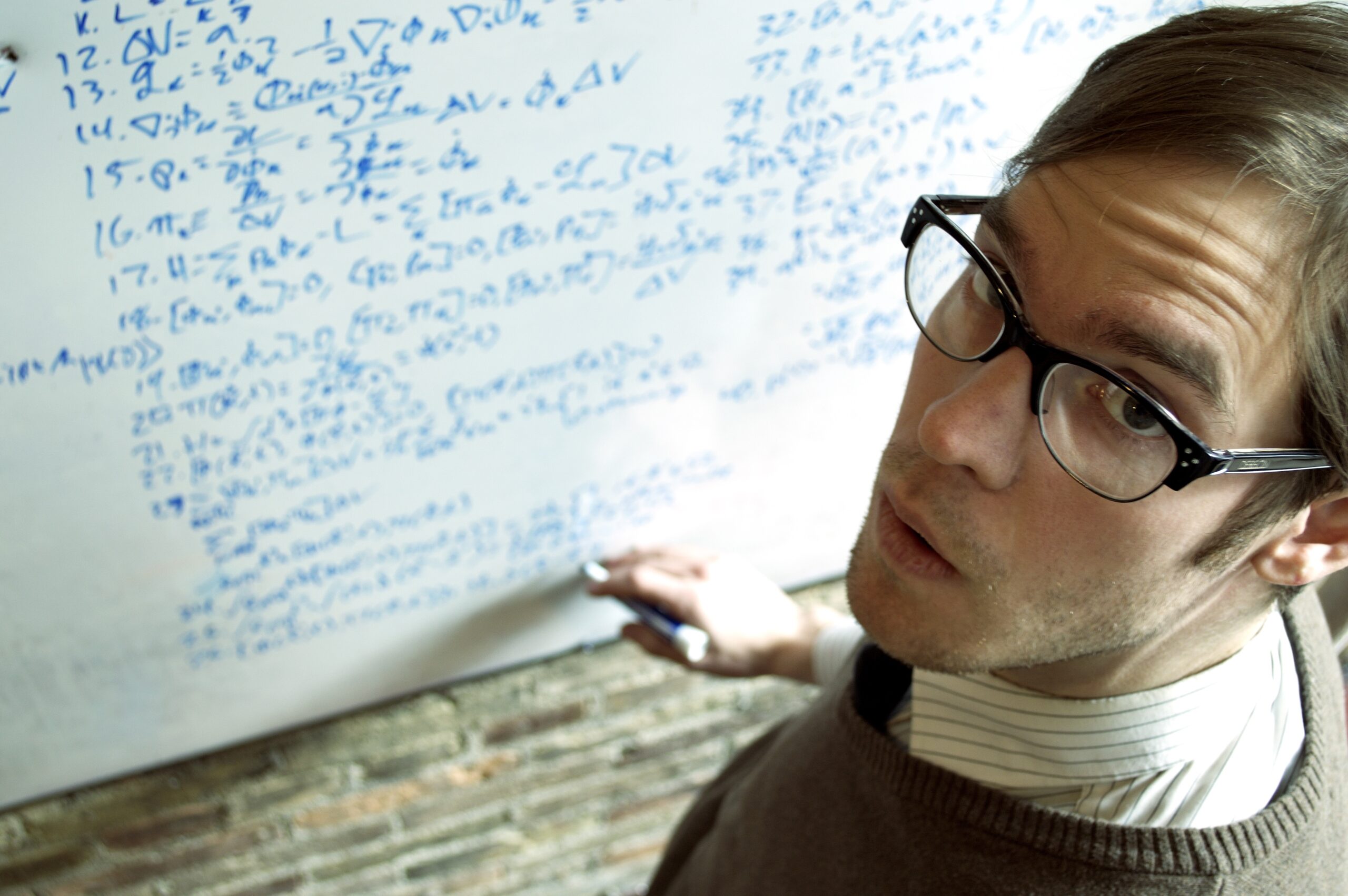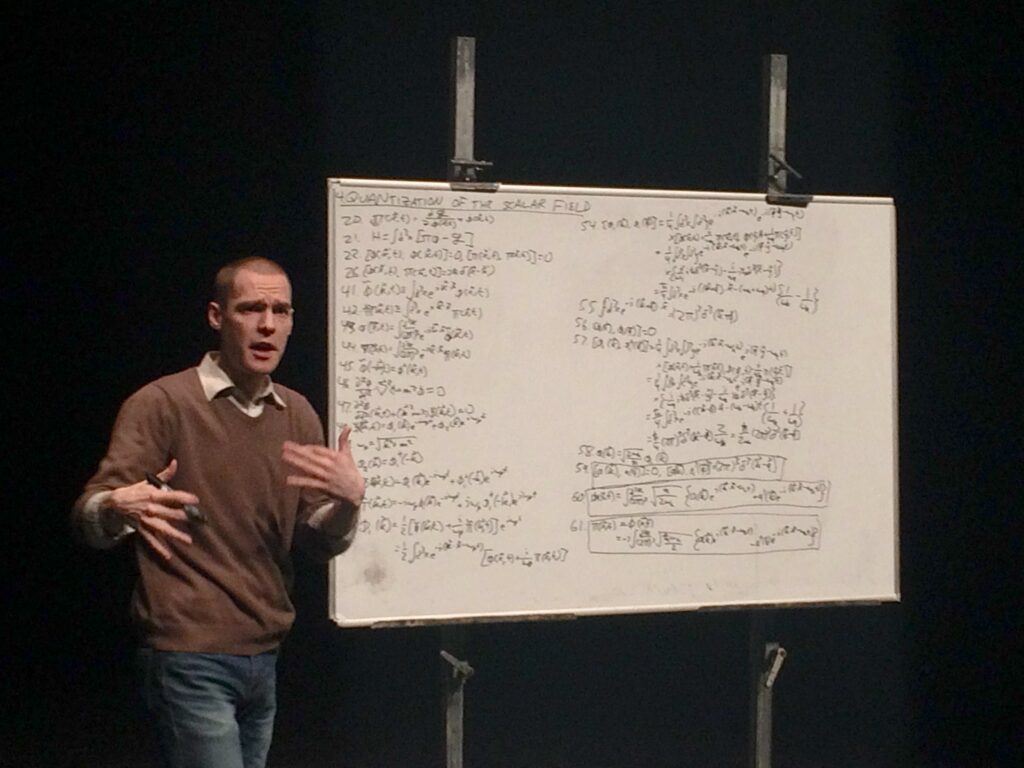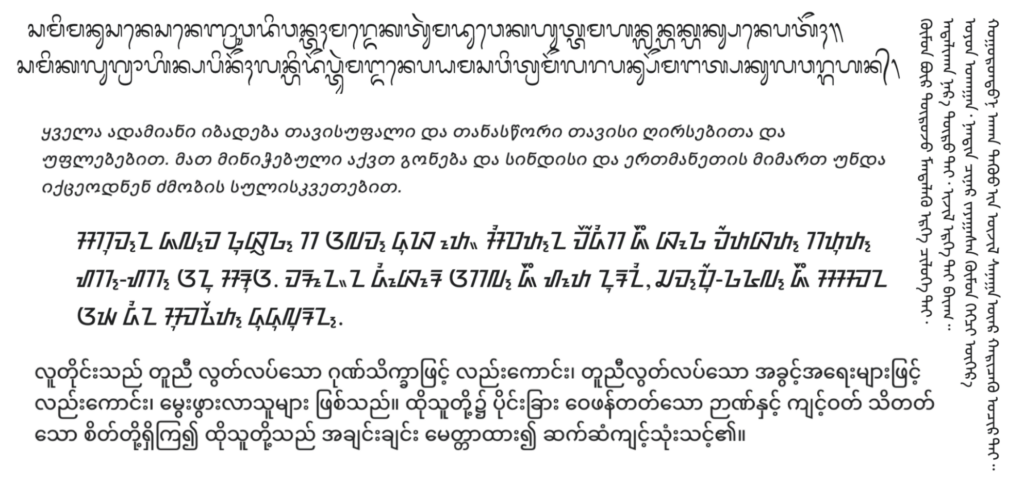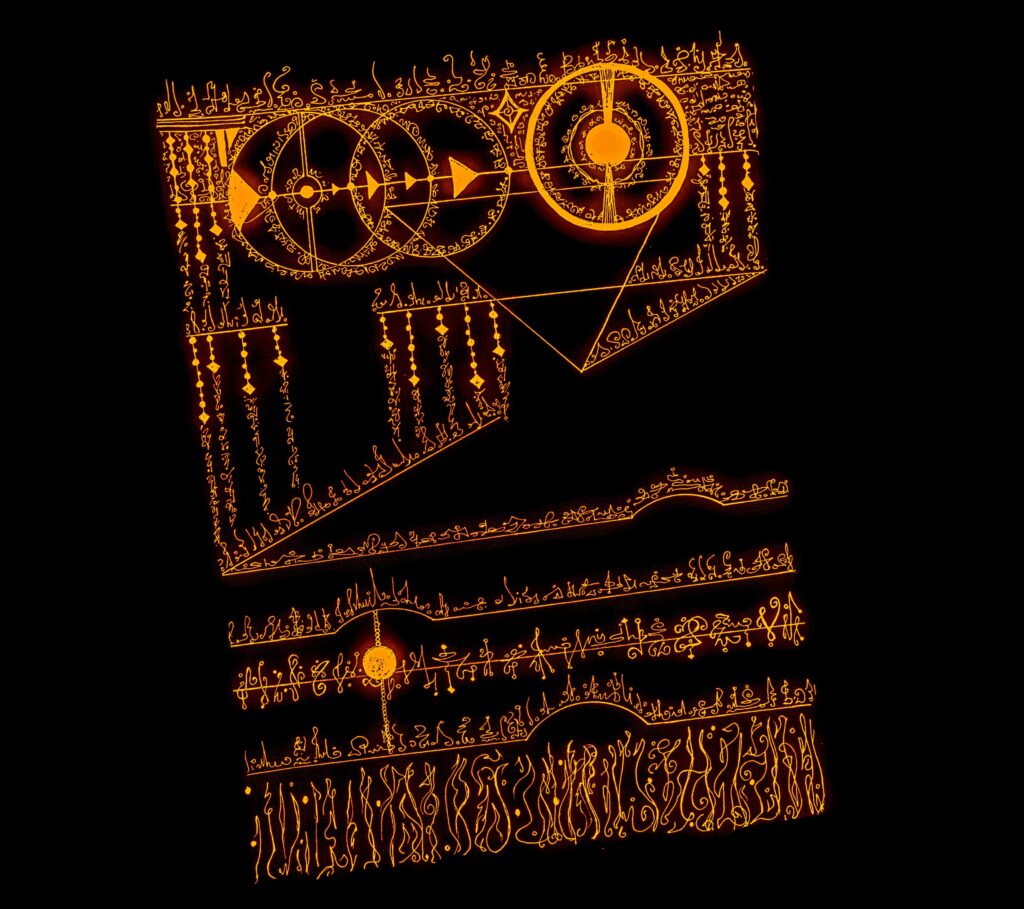“Random” Thoughts
The "random" as aesthetic judgment: on mathematics, language, and the search for meaning

JUST TRYING TO BE RANDOM
A few years ago I developed SEMESTER, a performance where I deliver a full relativistic quantum physics lecture, verbatim. I stand at a chalkboard or whiteboard and write each equation as I recite the lecture, filling the board over the course of 45 minutes. I have no understanding of quantum mechanics whatsoever, but I memorized it phonetically, working the choreography of the chalk along with the recitation into muscle memory—so while I have no idea what I’m saying, I know exactly what I’m saying.

The piece provokes a range of responses. The conversations I have with audiences typically address what it means to “know” something, to “teach” or “learn” something, or how knowledge/expertise is performed; some viewers comment on the musicality of the language or the aesthetics of the equations, and of course I’m asked how I memorized it all.
Some archly question whether I actually accomplished the task SEMESTER proposes: whether I’m not simply saying random gibberish, or writing random equations on the board.
I’m curious about that word, “random,” not only in this context, but as an aesthetic judgment in general. I hear it about other performances I’ve made or seen: a suggestion the piece was “just trying to be random.” I sometimes even feel myself making that same judgment of “random” as an audience member—often in spite of myself. What provokes a spectator to make this judgment, and what assumptions does it index about the legibility of art? What does the judgment “random” indicate about the process of meaning-making, both in aesthetic contexts as well as more broadly, and is it possible for artists to harness or channel these patterns of attention and judgment to produce works that resist such assumptions about legibility and value?
THE RANDOM AND THE LANGUAGEY
In his sprawling meditation on the roots of consciousness, Gödel, Escher, Bach: An Eternal Golden Braid, Douglas Hofstadter considers the structure of messages between intelligent communicators, theorizing three layers that every message contains:
“We can separate out fairly clearly three levels of information: (1) the frame message; (2) the outer message; (3) the inner message. The one we are most familiar with is (3), the inner message; it is the message which is supposed to be transmitted: the emotional experiences in music, the phenotype in genetics, the royalty and rites of ancient civilizations in tablets, etc.
To understand the inner message is to have extracted the meaning intended by the sender.
The frame message [(1)] is the message ‘I am a message; decode me if you can!’; and it is implicitly conveyed by the gross structural aspects of any information-bearer.
To understand the frame message is to recognize the need for a decoding-mechanism.
If the frame message is recognized as such, then attention is switched to level (2), the outer message. This is information, implicitly carried by symbol-patterns and structures in the message, which tells how to decode the inner message.
To understand the outer message is to build, or know how to build, the correct decoding mechanism for the inner message. ”1
I’m particularly fascinated by his concept of a “frame message”: How do we recognize whether any given stimulus is a message at all? What kinds of “gross structural aspects” lead me to identify a series of beeps or lines as (potentially) meaningful—to register them as a sequence intended to carry meaning to someone who knows how to read it, even if I don’t yet know how?
Hofstadter later refers to these “gross structural aspects” of the frame message—the features of a message that indicate it as a message in the first place—as “aperiodic crystals,” borrowing the term from Erwin Schrödinger: recurring, recombinant sets of symbols or gestures within a geometric form which, while similar and repetitive, do not fall into a strict “pattern.” The lines of a barcode, the glyphs and symbols of a foreign language, or the impressive equations of a quantum physics lecture all strike me as conveying information from an intelligent sender—to someone—even though I don’t know how to read them myself: in Hofstadter’s terms, I haven’t yet mastered “(2), the outer message.”

I was especially interested in Hofstadter’s conception of “aperiodic crystals” because in my own artistic practice, I identify that same effect of seeming to carry meaning, albeit with a somewhat less sophisticated word: the languagey. Something seems languagey to me when it registers as potentially encoding a message: requiring, among other things, detecting a set of differences across many similar repetitions, and a context suited for communication.
In judging whether there is a communicative intelligence at work, I don’t identify simple geometric patterns such as the stripes on a bedsheet as a possible message: context aside, the stripes are too consistent, too simple to plausibly encode complex meaning. On the other hand, I don’t identify particle board wood grain as a possible message either: too much variation, with no clear syntax or structure, makes it seem—dare I say—random. In both cases, I don’t notice myself making the explicit decision, “This is not a message,” or, “This is too random to be legible,” I just regard them by their utilitarian functions—sheet, shelf—and leave it at that. Indeed, I’m skeptical about using the word “identify,” which makes it sound conscious and deliberate, since registering messages as such (or more commonly, precluding them) seems to be a pre-conscious judgment altogether.
Of course, these snap, pre-conscious judgments are advantageous in everyday life. The capacity to render such judgment, clearly represents an advantage in sparing us the cognitive load of investigating any given somewhat-repetitive sequence of stimuli on the disorganized (“random”) end of the spectrum. Beyond the usual list of perceptions we ignore—the feeling of clothes against our skin, the hum of electric lights, etc.—I cannot imagine taking the time and headspace to consciously consider every seeming pattern as a possible message. Hofstadter suggests this seemingly pre-conscious capacity to recognize the languagey trappings of intelligent communication (and accordingly discard others) as a major hallmark of consciousness, human or otherwise.
That said, perhaps the most important goal of my artistic practice is to make work that rehearses an investigative, symbolic gaze on the world: to see “things”—objects, gestures, systems—as always already more than their utilitarian function, to resist foreclosing thought, to practice curiosity and not-knowing, to find surprise and delight in everyday circumstances. I aim to develop a paranoia about one’s own certainty, to identify and critically resist methods through which our experience of the world has been designed, and to make the familiar unfamiliar. Staying with illegible perception is the first step.
Granted, I’m not proposing an explicit search for communicative messages: in writing this article, I found it all too easy to elide Hofstadter’s above framework—describing knowable, readable messages from senders to receivers—with the more open and abstract meaning-making that emerges from various levels of attention to things in the field of view such as art and performance. Of course there’s always something to be “read” from, e.g., patterns in wood grain. After all, things mean things: in that specific instance, dendrochronology is a whole field of drawing conclusions about the conditions of a tree’s lifespan, which are not (necessarily) explicit messages from the tree to the botanist. But we can experience the aesthetics of wood grain, or even relativistic quantum physics equations, without “understanding” them per se, or trying to read them for their semantic content. I’m convinced it’s the same preconscious flinch away from non-languagey stimuli that provokes a judgment of “random” in non-message contexts, and as an artist, I’m most curious about how to propose staying with material beyond that judgment—not even to ultimately discover “a signal in the noise,” but to appreciate what might initially be deemed noise, as a worthwhile experience in its own right.
So the stakes are kind of high for me: if there is some internal mental structure, or some external set of stimulus patterns, or (likely) the relationship between them, which decides whether some stimuli is sufficiently languagey to be worth further investigation or not—then understanding what precludes such thought or consideration, seemingly before it can even be consciously considered, is a crucial investigation. What’s the minimum level of pattern or structure that provokes a response of languagey? What are the conditions that provoke a commitment to search for meaning at all?
THAT’S SO RANDOM
In developing this writing, I encountered many different formal definitions alongside informal usages of the word “random.” There are several mathematical measures of “randomness,” for instance, and indeed, computer science is flush with techniques for producing “pseudorandom” numbers. Many statistical measures of randomness exist, such as a chi-squared test, the diehard test battery, TestU01, Kolmogorov complexity tests, and the Hadamard transform—all of which assign values to the predictability of number sequences or data sets.
“Random” as a vernacular judgment, however—e.g., “You’re so random”—doesn’t have such rigorous methods of analysis, often standing in for more precise aesthetic judgments such as chaotic, surprising, or the non-sequitur. As a matter of fact, etymologically, this usage of “random” goes much further back than any statistical definition of randomness, according to Oxford English Dictionary editor-at-large Jesse Sheidlower, starting as “a noun in the 14th century, meaning ‘impetuosity, great speed, force or violence in riding, running, striking, et cetera, chiefly in the phrase “with great random.”’” Only in the 17th century did “random” start to take on the more contemporary connotation of “lacking a definite purpose,” and “the specifically mathematical sense we have [is] only from the late 19th century.”2
With respect to my own artistic research, I’m focused on this latter form of “random,” rather than a strict mathematical standard. That which provokes an audience to think, “That’s so random,” will necessarily be different for any given spectator, and obviously cannot be represented as a single number. The judgment says more about the spectator and the conditions under which attention is occurring.
Despite being a minor, everyday judgment (as opposed to the more philosophically-prestigious and stately aesthetics of the sublime or the beautiful), the aesthetic judgment “random” has important implications: it typically betokens a negative reaction to a series of stimuli that has not only been found meaningless, but it also rhetorically forecloses the possibility that meaning could develop in the future. While the spectator may continue attending to a given work, the judgment “random” implicitly suggests that any meaning found from then on is accidental at best. It’s an aesthetic judgment that rarely, if ever, reflects the intentions of the artist. And yet, I can’t deny jumping to that conclusion as an audience member on several occasions. “Random” reveals a presumed legibility of an artwork: I should be able to read this, and if I can’t it’s because the artist is being obscure on purpose. Thus the judgment “random” hurts you twice: first because, as Hofstadter seems to suggest, it comes before we have time to consider the work consciously, and second because “That’s so random” seems to preclude any further thought beyond that judgment.
We can compare this with how critical theorist Sianne Ngai theorizes the aesthetic judgment “interesting.” In her seminal work Our Aesthetic Categories: Zany, Cute, Interesting, Ngai brilliantly expounds on the perlocutionary force of judging something as “interesting”:
“…when I am compelled to make public my appraisal of something as interesting, I am speaking precisely from my conviction that it is objectively worth paying attention to and appraising, regardless of my appraisal’s vulnerability to time. When we judge, say, a bad movie to be interesting (and when we say interesting, we often do mean ‘bad but nonetheless interesting’), we are therefore essentially making a plea for extending the period of the act of aesthetic evaluation: let us keep on talking about this movie; let us continue giving it attention even though it is not particularly good.”3
Ngai writes about the interesting as another minor affect, a judgment so minor that it sometimes barely registers as a judgment at all. If nothing else, it suggests, “Let’s keep thinking about this thing.” But where “That’s interesting” provokes further consideration and discourse about aesthetic experience, “That’s random” is tautologically dismissive, with a stoppage of further discourse or investigation, akin to a thought-terminating cliché.
“…when someone feels compelled to make public his evaluation of an object as interesting, we seem equally compelled to ask immediately: why? Here, aesthetic evaluation seems no longer finalized by the act of making an aesthetic claim but rather to have just gotten on its way.”4
On a pedestrian level, the random is invoked as a foreclosure of thought, which does not solicit claims for evidence the way Ngai suggests judging something to be “interesting” does. I’m not sure how a conversation would continue beyond the reply, “Why do you find it random?” without fully deconstructing the relations within the work and the expectations each spectator holds; often the tone of “That’s so random” alone is sufficient to dissuade further discourse. Always delivered as if self-evident, the force of the judgment is implied as sufficient to constitute its own justification. In this way, “random” works much how Ngai theorizes the force of the judgment “beautiful”:
“…when someone proclaims that she finds a tree or a poem beautiful, the force of the conviction underlying the judgment tends to route our attention immediately back to the sheer event of her having found it so. This is why it can be so strangely difficult to respond to someone’s passionate declaration that something is beautiful, whether one agrees with the person’s judgment or not. Whether we nod in sympathetic agreement or politely say nothing, we are likely to feel like any response we might have to the response of the judging subject, however not unwelcomed, is somehow beside the point. As Hockney and Rivers note, there is something ‘final’ about the beautiful, which often seems to double as a signal that the period of aesthetic evaluation and even experience has ended.”5
“That’s so random” signals a similar finality. However, unlike the beautiful, which presumably has the benefit of more prolonged and continued contemplation, the random is often the subject of a snap judgment, before leaving off further investigation entirely. As Ngai concludes, “…the interesting suspends a once-and-for-all appraisal in favor of a ‘continuing attention directed at the object’ that might help us figure out why it made us go ‘Huh?’ in the first place.”6 The random—when identified as such—hardly enjoys that suspension, and the “Huh?” felt at its onset only serves as evidence that the random isn’t worth staying with to figure out.
PICK A CARD
The random shares another property with Ngai’s conception of the interesting. To illustrate, I’m going to use an online number generator to randomly select a number from 1 to 1000:
Maybe there are coincidental associations with 754—if that’s your address or area code, for instance—but it doesn’t strike me as especially interesting. Crucially though, it doesn’t strike me as particularly “random” either, despite literally being a randomly generated number. I’m fudging a distinction between “arbitrary” and “random” here (more on that later) but what’s important is that random generation of numbers or words don’t per se evoke an aesthetic of randomness.
Instead, the judgment requires a series. Ngai indicates that “interesting” is almost etymologically tied to presenting things or information in an open series:
“In creating meaning through this logic of things placed next to or between others placed next to others in turn, there is thus a sense in which the series is an inherently interesting form, one reminding us that inter esse means ‘to be between; in the interval,’ or ‘among and in the midst of things.’…The interesting [is] a style explicitly about difference and the acts of comparison that make its perception possible.”7
Only in perceiving a series of things next to each other and within a given context, can we reach a judgment of either “interesting” or “random.” “Interesting” as a style thrives when an object is presented in an open series, where a hooked and engaged spectator might imagine many possible continuations. “There is thus a sense, as Shlegel’s fellow Athenaeum contributor Novalis notes, in which what is most interesting is the presentation of an object in series-–(series of variations, modifications, etc.).”8
The random similarly requires a series of objects or things for the potential of the languagey to either take hold or fail. When perceiving such a series, connections can be made (or not) between the entries, and this sheds light on the extent to which an “aperiodic crystal” requires time and iteration to demonstrate its aperiodicity: if I told you that 754 was followed in a sequence with 755, 756, 757, 758…, then the pattern is all too clear. A different sequence, like 754, 741, 728, 715…, might take a little more thought, but my immediate impression at first glance is that there is some kind of a connection worth investigating further. In contrast, if I gave the sequence as 504, 393, 891, 610, 77, these might by chance come from some kind of complicated pattern—but my initial judgment is that they are random. The point is that randomized methods of composition (like my initial 754) don’t necessarily mimetically provoke the judgment of random any more than a single base pair from DNA provokes a sense of legibility.
I’m intrigued by this discontinuity between randomized generation and aesthetic judgment. There are whole art-historical movements of works produced through chance operations, yet my impression of these choreographies or sound pieces has often been of a cohesive, if unconventional, whole. Certainly artists such as John Cage set the parameters around which their chance operations unfold, but I suspect my spectatorship is more primed—if not disarmed—by how these works show their cards from the outset: I don’t exactly jump to “that’s so random” when the artwork has already told on itself. In contrast, more recognizable expressions of the random are often centralized compositions. Forms such as children’s cartoons often represent “randomness” with a tellingly predictable array of animals, foodstuffs, and unprovoked violence, in a formulaic structure that resolves in time for a commercial break.
Another form through which this tension plays out is in that of asemic writing, an abstract visual art practice which features text-like lexical gestures without any semantic meaning. To borrow Hofstadter’s description, asemic writing deploys the “gross structural aspects” that betoken the “(1) frame message” of written language, while intentionally withholding the “(2) outer message”—recognizable words and letters themselves. Asemic writing undoubtedly triggers a sense of the languagey, and as a viewer I feel some non-conscious part of me continuously oscillate between recognizing the work as “potentially legible” and then “illegible,” and back again.


Still another example where the random is leveraged—and my long-term object of research—is the performance of tarot card readings. As an artist, I’m particularly fascinated by the level of commitment I experience from participants, to a selection of symbols in any given spread drawn at random from a shuffled deck. Of course this is a gross oversimplification of the dramaturgy at work in tarot—and there are certainly plenty of idiosyncratic methods of performing readings—but it’s worthwhile to hazard generalizing the setup of a tarot card reading vis-à-vis Hofstadter’s framework, to theorize what elements of a reading draw so much commitment from their spectators, despite a good deal of “randomness” in their form and content.
Through the act of shuffling, the tarot cards are explicitly randomized in front of the spectator; the object of a shuffled deck of cards is rightly clichéd in its evocation of randomness, with more possible arrangements than there are atoms estimated in the observable universe. Yet, there is a strong sense of the languagey throughout the deck. In terms of Hofstadter’s frame message, the tarot provides a vivid and enticing range of symbols as its frame message, nestled within congruent rectangles stacked into a pile. The distribution of numbers and symbols throughout the deck is certainly languagey, in that they recombine suited symbols (swords, wands, cups, and pentacles) with numbers 1-10, plus court cards (page, knight, queen, and king), and 22 additional numbered major cards with their own host of symbolic interconnections. Depending on the deck, these can be further interspersed with other recurring images—the Waite-Smith deck, for instance, scatters castles, flowers, churches, mountains, deserts, and gardens in the cards’ backgrounds, to name a few. Even before assigning meanings to any card, number, or image, the deck (and any spread drawn from it) definitely registers as an aperiodic crystal, and all but guarantees chance accordances by some number or set of images in a spread.

The outer message also strongly encourages commitment to reading. Whereas the dots and lines that comprise a musical score intuitively have very little correspondence with the tones they are intended to represent, the symbols and characters throughout the tarot afford a wide range of poetic connotations which can lead to very straightforward, intuitive readings. Likewise, books and guides on card meanings frequently use vague but inspiring words or phrases, which similarly stir the imagination. Here I find an intriguing opposition between notions of “arbitrary” and “random” symbols. In my research, I use “arbitrary” to suggest the idea that a committed spectator can find meaning in any given symbol or image—whereas the “random” asserts, “I’m not going to commit to reading into these symbols; there’s nothing there to find.”
On top of all this, a major convention of tarot performance is that both the performer and spectator commit to the legibility of these symbols, as well as committing to the conviction that there is an inner message to be found, and the cards are showing the way: even if we don’t initially understand, we’re wrong, not the cards. The one-on-one nature of card readings conveys to the spectator that the cards are “yours,” in the second person. That the spectator’s own thoughts about themselves during the reading are ascribed to revealed truth from the cards is a mechanism that further inculcates a commitment to legibility.
NOT ONLY DOES GOD PLAY DICE…
Throughout this article I’ve shown “random” in a bit of a negative light, focusing on situations where that judgment is tantamount to a dismissal of the situation and any further thought. It’s clear, however, that this needn’t always be the case—that the random can be carefully deployed to propose rich opportunities for audiences to exercise meaning-making, as opposed to precluding it.
In my opening example of SEMESTER, the spectators who questioned whether I was writing “random equations” weren’t necessarily suggesting this to be dismissive of the performance. What draws me to the quantum physics language may be what pushes others away: a seemingly inscrutable vocabulary and notation bordering on the arcane. In a lecture context, it makes sense that such bewildering jargon would strike some viewers as simply not languagey: if there is no discernible meaning behind it, I may as well be making it up. This is especially understandable within the context of an academic lecture, where the traditional mode of spectatorship focuses attention specifically upon an expert’s speech so as to learn the material. SEMESTER short-circuits this logic of lecture by presenting an “expert” who never knew the material to begin with, to an audience not expected to learn.
However, when compositional strategies are disclosed as random—through a shuffle, a scribble, or a series of coin flips—the audience is left to grapple with meaning-making themselves. Confronted by a Cage composition, a piece of asemic writing, a tarot card spread, and others, the spectator is aware from the beginning that due to the randomness of composition, no explicit message has been prepared for them. However, rather than throw one’s hands up in the face of the random, each form gives an abundance of “gross structural aspects” to navigate: by invoking the languagey and creating contexts where meaning is found among a forest of things and signs, spectators can commit to staying with the illegible—in aesthetic contexts as well as beyond—when they may otherwise have dismissed it as “just being random.”